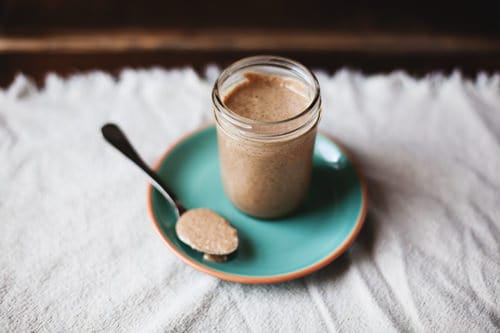My whole family loves nut butters. For breakfast, raw almond butter slathered on a piece of warm toast with melty butter underneath, gobbled up while it’s still gooey. For a snack, roasted peanut and raw sesame-seed butter smeared on crisp apple slices. For dinner, peanut butter made into a sauce over chicken, vegetables, and rice. And any ol’ time of the day, any ol’ type of nut, licked right off a spoon. You name it, we love it. And since nuts are a heart-healthy source of protein, I don’t feel too bad about keeping it around the house. But the little folk in our household can be rather particular about theirs—if the nut butter is too sweet or chunky or not sweet enough, it doesn’t make the cut. They like what they like and are rarely fooled.
Once I became more aware of food quality and the importance of reading the list of ingredients, I began to buy and test different types of nut butters (ones without sugar or hydrogenated oils) that my family has enjoyed in the past. We tasted some failures before finding a nut butter that all of us would eat. However, for a container of mashed up nuts, it came at a premium price. I also noticed that the further I moved away from common nut butters (I’m looking at you, peanuts), the higher the price climbed.
In my mind, I’d somehow decided I couldn’t create my own nut butters without a fabulous piece of equipment that could pummel nuts to the perfectly creamy texture that my family loves. After all, every recipe I found online recommended the use of one of those high-end, mega-powered blenders. Don’t get me wrong—I covet such a high-end kitchen toy, but I just have yet to invest in one.
I finally realized that my quest for the perfect homemade nut butter had become a tad more complicated than necessary. As I added almond butter to my grocery list, I thought to myself: “You know, I have a bunch of raw almonds. I have a food processor. What’s the worst that can happen? A batch of nut butter that only I will eat? So be it!” I grabbed the stuff I needed and gave it a whirl—literally.
But before I got out the food processor, first I prepared the raw nuts by soaking and dehydrating them. Nuts prepared this way are called “crispy nuts.” Ideally, the key to a healthy nut butter is to first soak and dehydrate raw nuts so your body can digest them properly, as Sally Fallon explains so well in Nourishing Traditions: The Cookbook That Challenges Politically Correct Nutrition and the Diet Dictocrats.
After I prepared the nuts, I plugged in the food processor, threw in a few cups of crispy nuts, and flipped the switch. How excited was I to see the food processor transform whole nuts into the creamy goodness that my family enjoys? No chunks at all. Way to go, food processor! Once the texture was where I wanted it, it was time for a taste test. Would my boys go for it? Nope. It still needed some sweetness. So I added raw honey, a little at a time, until I was fairly certain they’d like it. It tasted great. Hip, hip, hooray!
The ultimate taste test took place later that afternoon when they got home from school. I knew exactly what I’d be giving them for their snack: apple slices and almond butter. And they gobbled it up like any other day. When I asked if they liked the almond butter, they looked at me all strange. Then our oldest said, “Um, yeah. We always do. Why?”
Success! When I told them I made it myself, they weren’t quite as excited as I was. But the great thing was that they didn’t notice a difference between my almond butter and the store-bought one. Now my boys eat my homemade almond butter all the time. It’s much easier on our food budget to simply buy raw nuts, soak and dehydrate them, and plug in the food processor.
Since that first shocking revelation I’ve diversified our nut butter palates quite a bit. Sometimes I’ll throw in a handful of walnuts or pecans. Other times I’ll add a spice like cinnamon or nutmeg. And raw sesame-seed butter, also known as tahini, is a great raw protein to add to more flavorful nut butters like roasted peanut. I’m also eager to try a little ground chipotle pepper for some kick, and change up the sweetener with unsulphured blackstrap molasses. Another great source of recipes for crispy nuts, nut butters, and from-scratch condiments is the book Internal Bliss.
Don’t be fooled. Nut butters are about as versatile as you can get and so easy to make in your own kitchen that you’ll be shocked. Or have you already figured this out on your own? If you have, what’s your all-time favorite nut butter flavor combination?
Photo Credit: CC/the little red house




Hi Paula, I just finished writing a Q & A on making almond flour/meal at home in your food processor or coffee grinder. Ironically if you process the almond flour too much, you get almond butter. The secret for the right consistency for nut ‘flour’ is not to soak the nuts. Thanks for the tips. I enjoy your column.
Hello Phyllis, I have found the exact same thing to be true. Thank you for taking the time to point it out here. Also, thanks for taking the time to read my column AND comment! I truly appreciate it and have a lot of fun with the writing. :) Hugs!